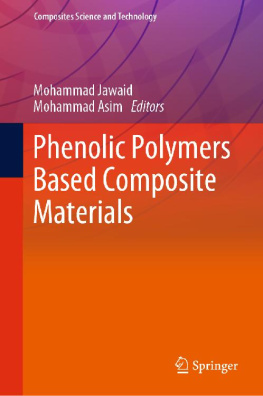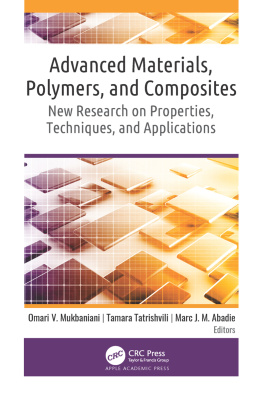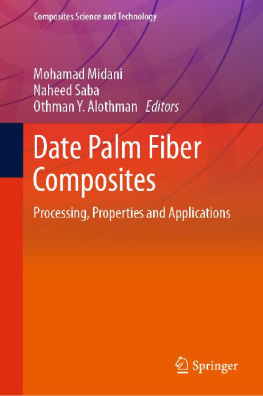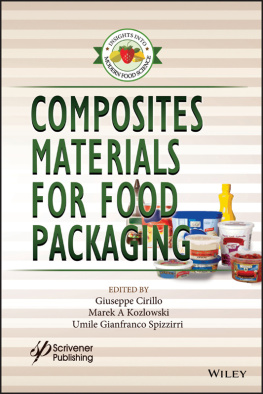Composites Science and Technology
Series Editor
Mohammad Jawaid
Lab of Biocomposite Technology, Universiti Putra Malaysia, INTROP, Serdang, Malaysia
Composites Science and Technology (CST) book series publishes the latest developments in the field of composite science and technology. It aims to publish cutting edge research monographs (both edited and authored volumes) comprehensively covering topics shown below: book series publishes the latest developments in the field of composite science and technology. It aims to publish cutting edge research monographs (both edited and authored volumes) comprehensively covering topics shown below:
Composites from agricultural biomass/natural fibres include conventional composites-Plywood/MDF/Fiberboard
Fabrication of Composites/conventional composites from biomass and natural fibers
Utilization of biomass in polymer composites
Wood, and Wood based materials
Chemistry and biology of Composites and Biocomposites
Modelling of damage of Composites and Biocomposites
Failure Analysis of Composites and Biocomposites
Structural Health Monitoring of Composites and Biocomposites
Durability of Composites and Biocomposites
Biodegradability of Composites and Biocomposites
Thermal properties of Composites and Biocomposites
Flammability of Composites and Biocomposites
Tribology of Composites and Biocomposites
Bionanocomposites and Nanocomposites
Applications of Composites, and Biocomposites
To submit a proposal for a research monograph or have further inquries, please contact springer editor, Ramesh Premnath (ramesh.premnath@springer.com). To submit a proposal for a research monograph or have further inquries, please contact springer editor, Ramesh Premnath (ramesh.premnath@springer.com).
More information about this series at http://www.springer.com/series/16333
Editors
Mohammad Jawaid and Mohammad Asim
Phenolic Polymers Based Composite Materials
1st ed. 2021
Editors
Mohammad Jawaid
Laboratory of Biocomposite Technology, Universiti Putra Malaysia, Serdang, Selangor, Malaysia
Mohammad Asim
Laboratory of Biocomposite Technology, Universiti Putra Malaysia, Serdang, Selangor, Malaysia
Composites Science and Technology
ISBN 978-981-15-8931-7 e-ISBN 978-981-15-8932-4
https://doi.org/10.1007/978-981-15-8932-4
Springer Nature Singapore Pte Ltd. 2021
This work is subject to copyright. All rights are reserved by the Publisher, whether the whole or part of the material is concerned, specifically the rights of translation, reprinting, reuse of illustrations, recitation, broadcasting, reproduction on microfilms or in any other physical way, and transmission or information storage and retrieval, electronic adaptation, computer software, or by similar or dissimilar methodology now known or hereafter developed.
The use of general descriptive names, registered names, trademarks, service marks, etc. in this publication does not imply, even in the absence of a specific statement, that such names are exempt from the relevant protective laws and regulations and therefore free for general use.
The publisher, the authors and the editors are safe to assume that the advice and information in this book are believed to be true and accurate at the date of publication. Neither the publisher nor the authors or the editors give a warranty, expressed or implied, with respect to the material contained herein or for any errors or omissions that may have been made. The publisher remains neutral with regard to jurisdictional claims in published maps and institutional affiliations.
This Springer imprint is published by the registered company Springer Nature Singapore Pte Ltd.
The registered company address is: 152 Beach Road, #21-01/04 Gateway East, Singapore 189721, Singapore
Preface
Phenolic resins are the one of the oldest resins and have received great attention from academic researchers, industrial works and one of good and acceptable resin for industrial applications among all thermoset resins. Several effective attempts have been made to explore different synthesis processes of producing phenolic in a more useful and advanced way. Phenolic resin has some peculiar properties such as easy handling, toughness, excellent flame retardance, good heat resistance, low smoke/toxic gas evolution and highly thermal stability. Since the date of innovation of phenolic resin, wood/fibre reinforced biocomposites and composites products have been produced for various applications.
This book will explore potentiality of the chemical structure of phenolic resins and its derivatives. Nowadays, synthesis of phenolic resin from natural resources or biomass attracting researchers and academician to conduct in depth characterization such as mechanical, thermal, and rheological properties to look suitability of bio-phenolic resin in market as compared to synthetic phenolic resin. Phenolic will also be used with biodegradable materials to provide lightweight materials for outdoor applications. With this approach, phenolic resin can easily enter in eco-friendly market segments and can be a promising material for the automotive, marine, aerospace, construction and building, wind energy and consumer goods, etc.
This book has clearly shown the beginning and transformation of phenolic which helps to understand this polymer and its utilization in the real world as per the need of markets. This book covered history of phenolic and its transformation (derivative), biobased phenolic natural fibre-based phenolic composites, wood-based phenolic composites, nanocellulose phenolic composites, thermal and fire retardant properties of phenolic and its composites. This versatile version of phenolic resin and its composites helps to develop lightweight and durable components which can be used for heavy duty.
We are highly thankful to all authors who contributed book chapters and provide their valuable ideas and knowledge in this edited book. We attempt to gather all the scattered information of authors from diverse fields around the world (Brazil, China, Australia, Bangladesh, USA, Thailand, India and Malaysia) in the areas of phenolic composites and biocomposites and finally complete this venture in a fruitful way. We greatly appreciate contributors commitment for their support to compile our ideas in reality. We are highly thankful to Springer Nature, Singapore team for their generous cooperation at every stage of the book production.
Mohammad Jawaid
Mohammad Asim
Serdang, Malaysia
Contents
Caroliny Santos , Thiago Santos , Rubens Fonseca , Ktia Melo and Marcos Aquino
Banchamlak Bemerw , Magdi Gibril , Shoujuan Wang and Fangong Kong
Ing Kong
Thiago Santos , Caroliny Santos , Rubens Fonseca , Ktia Melo and Marcos Aquino
G. Rajeshkumar , D. Elangovan and V. Rajkumar
Maliha Marzana , Md Imran Howlader and Md Milon Hossain
Chandrasekar Muthukumar , J. Naveen , T. Senthil Muthu Kumar , K. Senthilkumar , P. S. Venkatanarayanan , M. R. Ishak and Suchart Siengchin
K. Senthilkumar , I. Siva , S. Karthikeyan , Harikrishnan Pulikkalparambil , Jyotishkumar Parameswaranpillai , M. R. Sanjay and Suchart Siengchin










